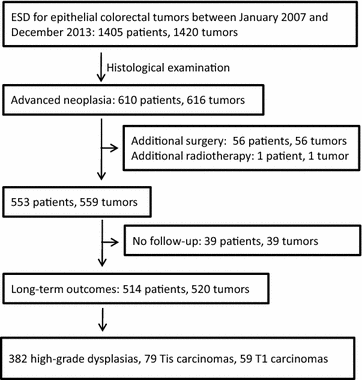Long-term outcomes of endoscopic submucosal dissection for high-grade dysplasia and early-stage carcinoma in the colorectum
- PMID: 29764504
- PMCID: PMC5993150
- DOI: 10.1186/s40880-018-0273-4
Long-term outcomes of endoscopic submucosal dissection for high-grade dysplasia and early-stage carcinoma in the colorectum
Abstract
Background: Colorectal carcinomas (CRCs) arise from premalignant precursors in an adenoma-carcinoma sequence, in which adenoma with high-grade dysplasia (HGD) and early-stage carcinoma are defined as advanced neoplasia. A limited number of studies have evaluated the long-term outcomes of endoscopic submucosal dissection (ESD) for advanced colorectal neoplasia. This study aimed to assess the efficacy and safety of ESD for advanced colorectal neoplasia as well as the long-term outcomes, including local recurrence and metastasis.
Methods: We analyzed data collected from 610 consecutive patients with 616 advanced colorectal neoplasia lesions treated with ESD between January 2007 and December 2013. Clinical, endoscopic, and histological data were collected over a median follow-up period of 58 months to determine tumor stage and type, resection status, complications, tumor recurrence, and distant metastasis.
Results: The overall rates of en bloc resection, histological complete resection, and major complications were 94.3%, 89.4%, and 2.3%, respectively. Hybrid ESD was an independent factor of piecemeal resection. Tumor location in the colon was associated with increased risk of ESD-related complications. During the follow-up period, all patients remained free of metastasis. However, local recurrence occurred in 4 patients (0.8%); piecemeal resection was a risk factor.
Conclusions: ESD is effective and safe for resection of advanced colorectal neoplasia, with a high en bloc resection rate and favorable long-term outcomes. ESD is indicated for the treatment of HGD and early-stage CRC to obtain curative resection and reduce local recurrence rate.
Keywords: Colorectum; Early-stage carcinoma; Endoscopic submucosal resection; High-grade dysplasia.
Figures


Similar articles
-
Long-term outcomes of endoscopic submucosal dissection for colorectal epithelial neoplasms.Endoscopy. 2010 Sep;42(9):723-9. doi: 10.1055/s-0030-1255675. Epub 2010 Aug 30. Endoscopy. 2010. PMID: 20806156
-
Efficacy and Safety of Endoscopic Submucosal Dissection for Colorectal Carcinoids.Clin Gastroenterol Hepatol. 2016 Apr;14(4):575-81. doi: 10.1016/j.cgh.2015.07.048. Epub 2015 Aug 6. Clin Gastroenterol Hepatol. 2016. PMID: 26256463
-
Clinical outcomes of endoscopic submucosal dissection and endoscopic mucosal resection for laterally spreading tumors larger than 20 mm.J Gastroenterol Hepatol. 2012 Apr;27(4):734-40. doi: 10.1111/j.1440-1746.2011.06977.x. J Gastroenterol Hepatol. 2012. PMID: 22098630
-
AGA Institute Clinical Practice Update: Endoscopic Submucosal Dissection in the United States.Clin Gastroenterol Hepatol. 2019 Jan;17(1):16-25.e1. doi: 10.1016/j.cgh.2018.07.041. Epub 2018 Aug 2. Clin Gastroenterol Hepatol. 2019. PMID: 30077787 Review.
-
Endoscopic mucosal resection and endoscopic submucosal dissection: technique and new directions.Curr Opin Gastroenterol. 2017 Sep;33(5):315-319. doi: 10.1097/MOG.0000000000000388. Curr Opin Gastroenterol. 2017. PMID: 28704212 Review.
Cited by
-
Long-term prognosis of curative endoscopic submucosal dissection for early colorectal cancer according to submucosal invasion: a multicenter cohort study.BMC Gastroenterol. 2022 Sep 13;22(1):417. doi: 10.1186/s12876-022-02499-0. BMC Gastroenterol. 2022. PMID: 36100888 Free PMC article.
-
A Surveillance Endoscopy Strategy Based on Local Recurrence Rates after Colorectal Endoscopic Submucosal Dissection.J Clin Med. 2021 Oct 5;10(19):4591. doi: 10.3390/jcm10194591. J Clin Med. 2021. PMID: 34640609 Free PMC article.
-
Long-Term Outcomes of Endoscopic Submucosal Dissection for Colorectal Epithelial Neoplasms: A Systematic Review.Cancers (Basel). 2022 Dec 30;15(1):239. doi: 10.3390/cancers15010239. Cancers (Basel). 2022. PMID: 36612232 Free PMC article. Review.
-
IGF-1-mediated FOXC1 overexpression induces stem-like properties through upregulating CBX7 and IGF-1R in esophageal squamous cell carcinoma.Cell Death Discov. 2024 Feb 27;10(1):102. doi: 10.1038/s41420-024-01864-0. Cell Death Discov. 2024. PMID: 38413558 Free PMC article.
-
Early stage colon cancer: Current treatment standards, evolving paradigms, and future directions.World J Gastrointest Oncol. 2020 Aug 15;12(8):808-832. doi: 10.4251/wjgo.v12.i8.808. World J Gastrointest Oncol. 2020. PMID: 32879661 Free PMC article. Review.
References
Publication types
MeSH terms
Grants and funding
LinkOut - more resources
Full Text Sources
Other Literature Sources
Medical
Research Materials
Miscellaneous

